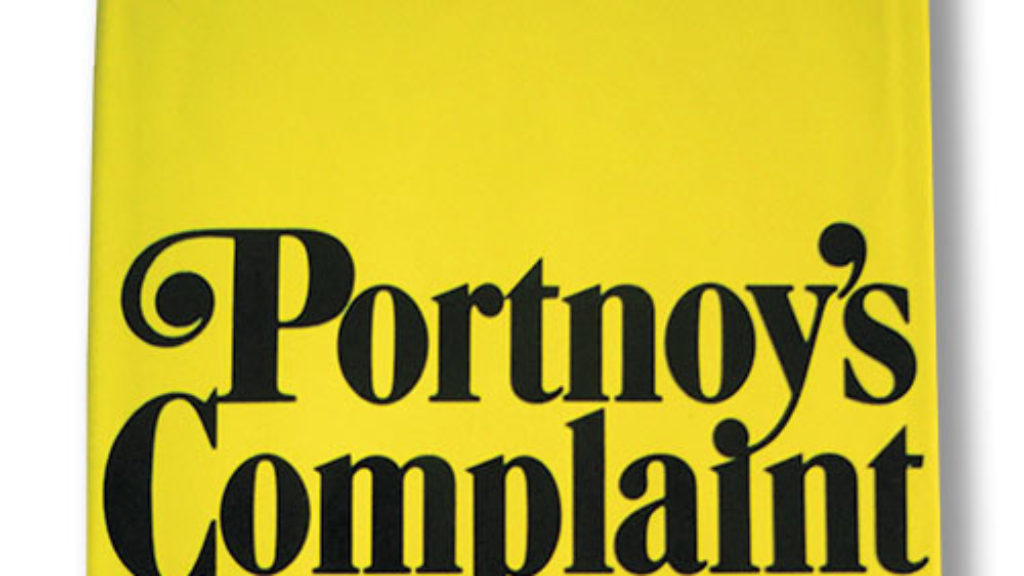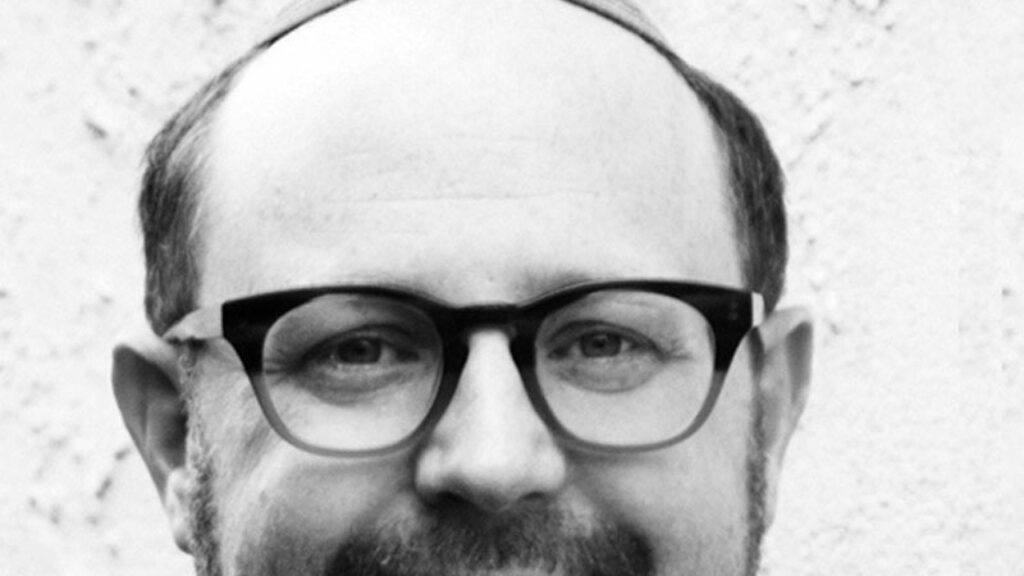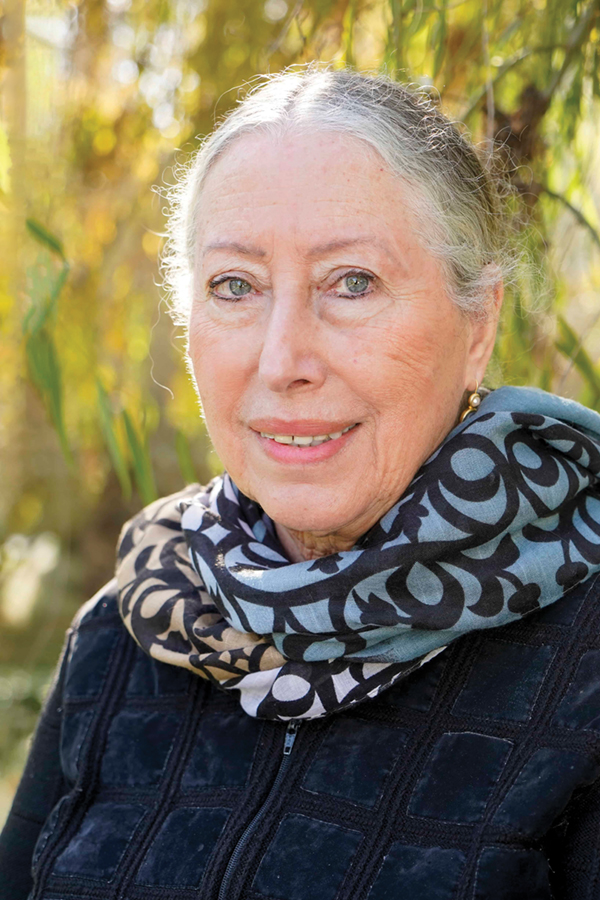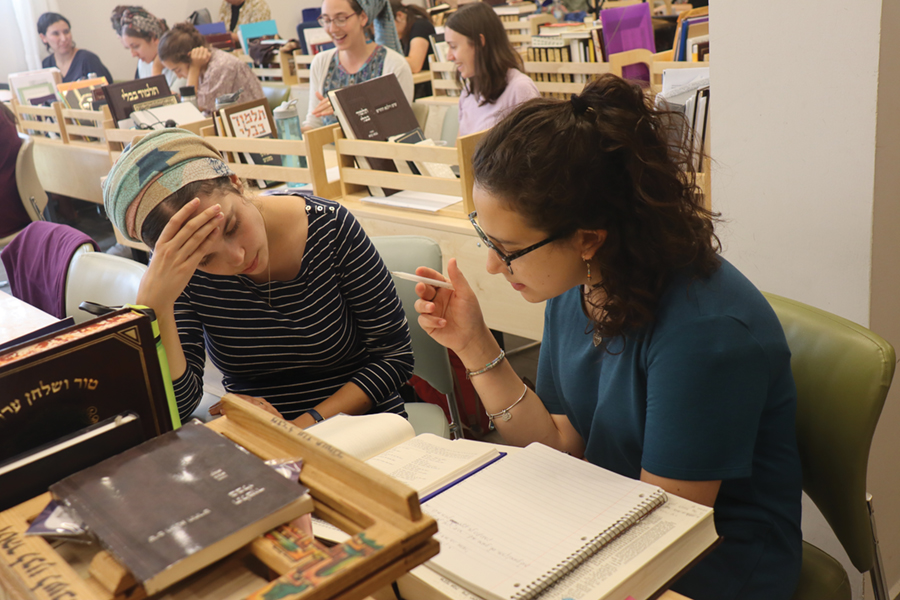An Unusable Past?
A few summers ago, I came across a student crying in the beit midrash. This isn’t terribly unusual—I run summer programs for teenage girls. But this time was different. The sobbing student had been introduced to Talmud study in her Jewish day school, but only on that day did she learn that the Tosafot, a commentary penned by Rashi’s students and their medieval disciples and printed on the pages of the standard Vilna edition of the Talmud, was written by men.
In the eyes of my student, those dense columns held a kind of mystique. She knew that these imposing glosses were the hardest stuff on the page. She also believed that Tosafot was written by a women’s collective—after all, the word ended with the feminine plural suffix –ot.
Of course, the Jewish study halls of medieval Europe completely excluded women. Even more, most Jewish women in those times could not read Hebrew let alone write talmudic metacommentaries. Rachel Elior’s newly translated 803-page tome, The Unknown History of Jewish Women through the Ages: On Learning and Illiteracy: On Slavery and Liberty, asks the fundamental questions: Where were the women? Why were we excluded?
Elior is an extraordinary and distinguished scholar. Born and raised in Israel, she was trained in Hebrew University’s Department of Jewish Philosophy and then taught there for decades. She has written on a stunning range of topics from Dead Sea Scrolls to Kabbalah, Sabbateanism, Chabad, and, now, Jewish women. This work originally appeared in Hebrew under the poignant title Grandmother Was Illiterate: On Learning and Illiteracy: On Slavery and Freedom. It draws on her wide-ranging interests, using not just history and philosophy but fiction, poetry, and the attendant secondary literature. But it is also a deeply personal work.
In laying out the problem that drives her book, Elior writes:
There is nothing in the halakhic literature or in modern scholarship until recent decades on the significance of this blanket denial of the right of girls and women to acquire knowledge through reading in the Holy Tongue. Nor is there any discussion of the cost of their exclusion from the exchange of opinions among students and teachers who inhabited the realm of written language, or of the far-reaching ramifications of denying the freedom of choice and the freedom of speech of those denied the possibility of learning to read the language of cultural communication of their people.
The majority of Elior’s massive book is taken up with simply documenting the gravity of this systematic exclusion.
As Elior recognizes, “The universality of the right to education and knowledge is a new idea, formulated in the nineteenth century and put into practice only in the twentieth century.” But if nobody had a concept of universal education before the modern period, can we really feel so angry at our ancestors for excluding their daughters? On the other hand, if the Jewish community prioritized education well beyond what was standard in the cultures around them, in which most men were illiterate, can we not feel some regret (and rage) as well? As Elior writes, “The sanctification of learning came at the cost of a pervasive system of gender oppression designed to exclude the female half of society from the public domain.” Moreover, this oppression was justified by rabbinic ideology:
Women were likened to inanimate soil or to the generative earth, as a paradigm of fertility, a passive space devoid of knowledge or understanding, voice or memory, acted upon by the master of the earth, who possesses knowledge and understanding, speech and memory.
In short, women existed to make bread and babies, not think thoughts.
Elior lays out a list (her book features many lists) of the “seven mechanisms of domination that men have employed against women,” to keep them, in effect, enslaved. She then shows how these mechanisms feature in the myth and law of Judaism, concluding with a chapter about status. “Status or standing,” she writes, “is always a function of the place in which one is allowed to stand, listen, speak and be counted, or, conversely, the place in which one is not allowed to stand.” In Elior’s view, the main place where women were never allowed to stand in Judaism “is the sacred place, near the Holy Ark, or the public domain where the sacred texts are kept.”
Elior’s chapter on status ends on a rare positive note, briefly describing the modern recognition of the values of equality and human dignity and how that awakening has brought change to Modern Orthodox, Conservative, Reform, and Reconstructionist Jewish communities. This is one of the only times in the book that these communities are mentioned, which is, at least to an American reader, a disorienting oversight. But Elior is an avowedly secular Israeli who sees the power center of Jewish religion in the Israeli chief rabbinate and Israel’s powerful haredi sector. For the most part, Modern American Judaism is not part of her story.
Throughout the book, Elior quotes dozens of traditional Jewish texts that discredit, devalue, and dehumanize women. How are we to square the values of equality and human dignity with these texts? For Elior, the only answer is a full erasure:
The . . . desired change is the cancellation of the patriarchal order and the utter rejection of all forms of male supremacy. . . . There can be no recognition whatsoever of the sanctity, applicability, or validity of laws that advocate compelling women “with the whip”, or assert that “he who teaches his daughter Torah, it is as if he teaches her licentiousness”, that “a woman’s only wisdom is that of the spindle”, and other stereotypes used to justify exclusion, degradation, and discrimination, and to label, shut out, and malign half of the community.
However, over the last half-century, many scholars who both love the Jewish canon and also see the challenges Elior raises have offered alternative approaches. For example, in a chapter titled “And He Shall Rule Over You,” Elior discusses at length the story of Adam and Eve as a foundational myth of inequality. She writes, “Culture has preserved extensive records of the form to which such relationships [eg marriage] are meant to aspire in hegemonic, abusive, oppressing, degrading, discriminating and violent patriarchal reality. These records can be found in myths.” Is there any other way to read Genesis? Many have tried to do so. Among rereadings that I find compelling is that of Rabbi Yehuda Henkin in Equality Lost, which was published a quarter century ago. Henkin reads the biblical text closely and concludes:
Man and woman were created equal, but from the first he related to her as an inferior; by doing so he caused her to stumble and the result was that she caused him to stumble, measure for measure.
To Henkin, Adam and Eve is the story of a tragic loss of equality, not a divinely ordained inequality. Henkin writes that we can and must work against it: “The recognition of equal capabilities of man and woman is a step towards fulfilling G-d’s intention that the one strengthen the other in observance of His word.”
Such rereading is what I encourage my students to do when we encounter difficult texts. I teach them that the Torah was given as a precious inheritance to all Jews—but that for generations many of its traditions were primarily carried by men who lived in contexts in which women were marginalized and undereducated, as Elior describes. Despite that history, I believe that our holy texts overflow their historical contexts and contain infinite truths. Our task, as laid out by the amusingly named Ben Bag Bag and Ben Hey Hey in Pirkei Avot, is to “turn it over and again turn it over,” trusting that we can find within our tradition the divine truth that resonates today, “for according to the labor is the reward.” As one example, when I show my students the teaching of Yose ben Yochanan in chapter 1 of Pirkei Avot—“engage not in too much conversation with women”—I ask them to consider, How much is too much? or in the more formal language of Talmud study, What is the shiur (measure) of “too much”? I suggest that perhaps the answer is “when she doesn’t want to talk to him anymore.” In this reading, every word of the Mishnah is accounted for and preserved but also renewed with dignity and truth. Elior would have us strike them from the canon or perhaps give up on the canon as a source of moral and spiritual teaching altogether.
When Elior comes to the eighteenth and nineteenth centuries, she paints a complex international picture of the beginnings of Jewish women’s education. In the second half of the nineteen century, the Alliance Israélite Universelle founded French-speaking schools for Jewish girls in Morocco, Iraq, Turkey, and Palestine, with forty-four girls’ schools spread around North Africa and the Middle East by 1912. A German-language school for Jewish girls was established in Berlin in 1869. Bais Yaakov was founded in Cracow in 1917.
Elior is very careful never to paint too rosy a picture of these early efforts. She quotes extensively from fiery rabbinic debates about the Bais Yaakov schools, including the remarks of the founder of the Sanz-Klausenberg Hasidic dynasty, Rabbi Yekutiel Yehudah Halberstam, who called such education the introduction of “licentiousness into a bulwark for the holy faith and chastity.” Moreover, Elior argues that these schools largely failed, though her criteria for success and historical evidence are left unclear. (In a long footnote, she writes, “In a survey I conducted among friends and acquaintance[s] in Jerusalem in their sixties and seventies, I discovered that most of their grandmothers, from various countries, were illiterate.” She goes on to tell stories of grandchildren trying to teach their grandmothers to read and the tension and discomfort educated Jerusalemites felt around their grandmothers who had grown up illiterate in Argentina, Morrocco, Russia, and elsewhere.)
Toward the end of the book, Elior collects “a number of disregarded, marginalized and silenced voices” in an attempt to “give voice, if only a murmur or distant echo, to the Jewish women excluded from Hebrew literature for thousands of years.” Some of her findings are delightful, like the female Yemenite scribe in the 1800s who wrote in a colophon to a Chumash she had copied: “Do not hold it against me if you find errors herein, for I am a nursing woman, Miriam daughter of Benaiah the scribe.” (I wish all nursing mothers today could append that line to their email signatures.) However, Elior limits the scope of this section in not putting these texts by women to work in addressing the issues of inequality laid out in the first half of the book. Many of the women she discusses were not just learned themselves but also teachers of Torah to other women, working against the illiteracy and marginalization that Elior has just spent hundreds of pages describing.
Among them was the sixteenth-century scholar Rebecca of Tiktin, author of the Meneket Rivkah, the first printed book written by a Jewish woman. Elior admits that Rebecca was “highly educated and pioneering” but then entirely fails to point out just how extraordinary her work truly is. The book is full of interpretive creativity, in which Rebecca cites a verse and a traditional interpretation, followed by her own, often astonishing, insight introduced with, “I could also expound the verse and teach it as follows.” The Meneket Rivkah is also riddled with subtly radical lines such as the one that refers to the first biblical couple as “Sarah and Abraham” or, even more jaw-dropping, describes marriage as “a daughter of Israel, who took a man.”
Elior also writes of the eighteenth-century scholar and liturgist Sarah Rebecca Rachel Leah Horowitz (as it happens, an ancestor of mine). Elior describes how “talented women raised in rabbinical families could become scholars and earn the admiration of their relatives and acquaintances” but does not show how Horowitz mobilized her learning to rail against the assumption that women are excluded from prayer, Torah study, and the observance of commandments. In the introduction to her Tkhine Imohos, for example, Horowitz writes, “Surely [the legitimacy of women’s prayer] does not escape any clear-eyed person.”
Beyond all of this, though, is Elior’s remarkable omission of women’s Torah scholarship in modern times. The book, for instance, contains not a single mention of Nechama Leibowitz, who was undoubtedly the most influential Bible teacher in Israel in the second half of the twentieth century (by contrast, Nechama’s brother, the scientist-theologian Yeshayahu Leibowitz, is cited several times). Despite her own career, Elior also fails to mention the tremendous advances women have made in the study of rabbinics within the academy, beginning with scholars such as Judith Hauptman and now followed by multitudes. This development is not unrelated to women’s Torah study outside the academy. Michelle Cohen Farber, through her organization Hadran, has taught full cycles of Daf Yomi in a fashion accessible to laywomen with little previous background in Talmud study. Were someone to transcribe Cohen Farber’s lessons, they would constitute the first full-length commentary on the Babylonian Talmud by a woman. Institutions like Matan, Lindenbaum, Drisha, Nishmat, Migdal Oz, Ein HaNatziv, Yeshiva University, and Yeshivat Maharat have created centers of advanced Torah study for women in Israel and the United States. The last generation has seen a revolution in women’s Torah literacy, but one wouldn’t know it from Elior’s book.
Today’s female Torah learners desperately need a usable past, one that neither imagines that the Ba’alei Ha-Tosafot were women nor dismisses the entire tradition as irredeemable. However, a book dedicated to the claim that “women have no written past,” even if it occasionally recognizes that the historical record is more complex, cannot be the place for its construction. Others will have to pick up the work where Elior leaves off.
Comments
You must log in to comment Log In
Suggested Reading

Disgruntled Ode
For a young daydreamer, nothing is more beautiful than the unspoken, which becomes the focus of desire. And the Jewish unspoken of my childhood was so vast that, within it, the imagination could reach near-spiritual proportions.
We Agree on Herzl
You know a review has turned mean-spirited when you’re indicted for crimes you quite carefully didn’t commit.

Law, Lore, and Theory
In his new book, Chaim Saiman points out that this “exclusive focus on the precise details of religious practice” left the Pharisees, the forebears of rabbinic Judaism, open to Jesus’s critique that they mistook “the legal trees for the spiritual forest.”
From the Middle to the End
A deceptively simple novel about a suburban, Midwestern Jewish family catapults into something annoyingly profound.


Martin Schulman
Some years ago I was called by a prominent woman Rabbi who was visiting New York from the West Coast. She explained to me that she had visited a well known Jewish book shop on Essex St. but the proprietor refused to sell her the book she sought. "Why, I asked?" "Because I am a woman. Please come down here", I was in Queens at the time, "and buy the book for me".
I did, the man did sell me the book which I then gave to her, and and after I drove here to one of the airports, went on my way.
I still wonder at the points of view that created this situation but upon deeper reflection I realize that it represents the culture within which I grew up. It took a better part of a lifetime, and often a very painful transition, to get over it.